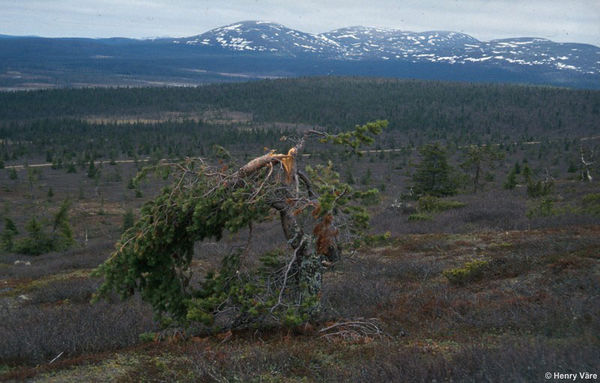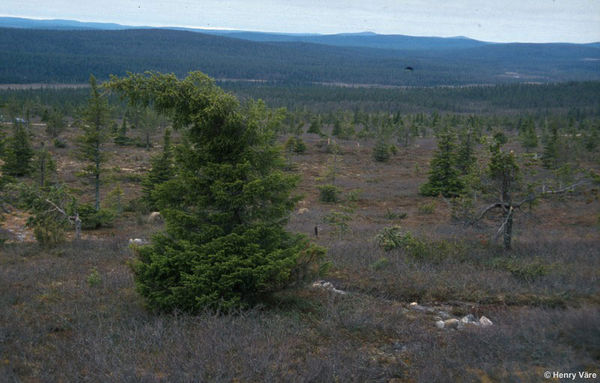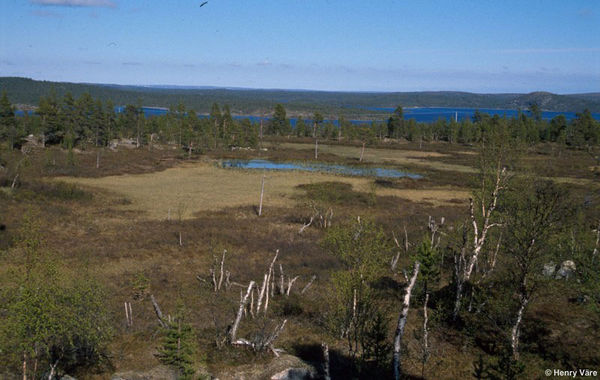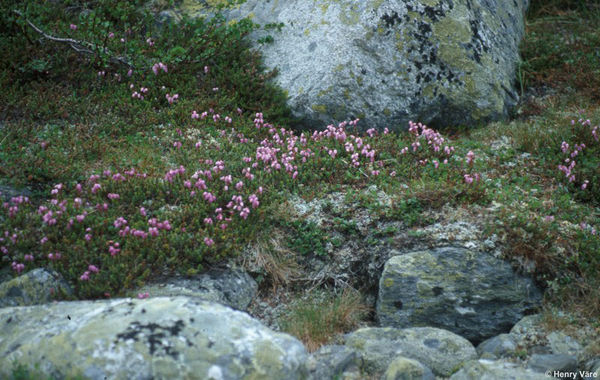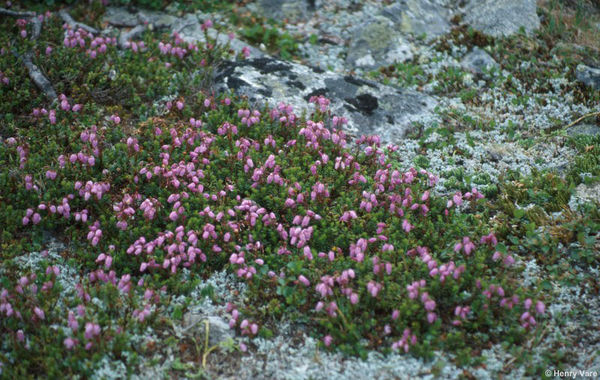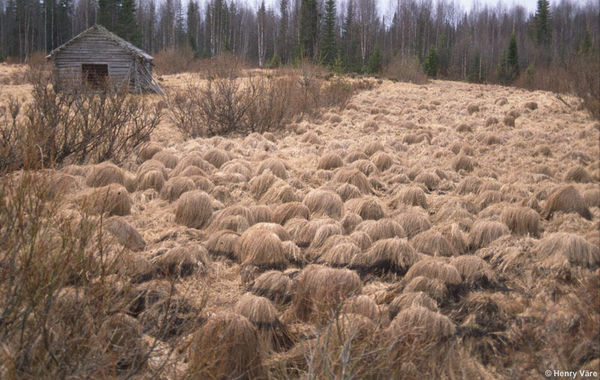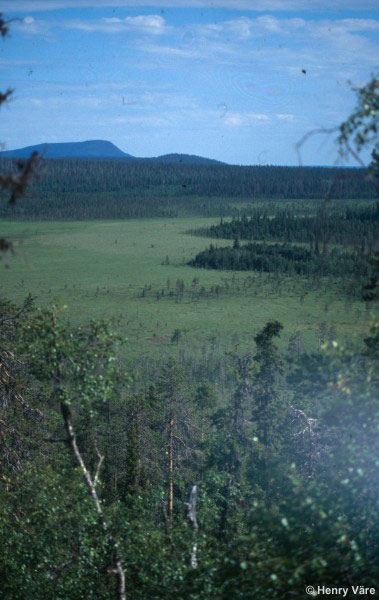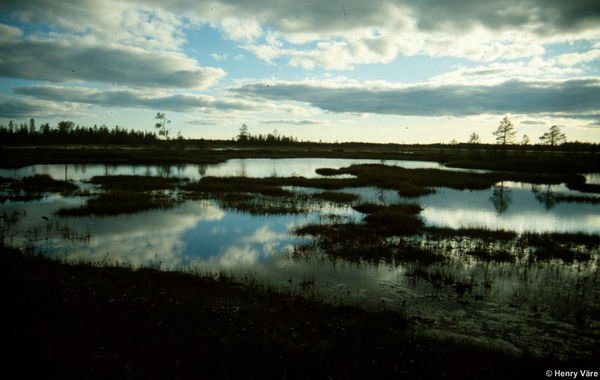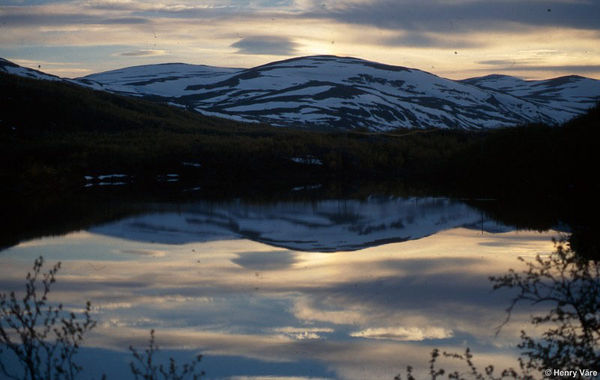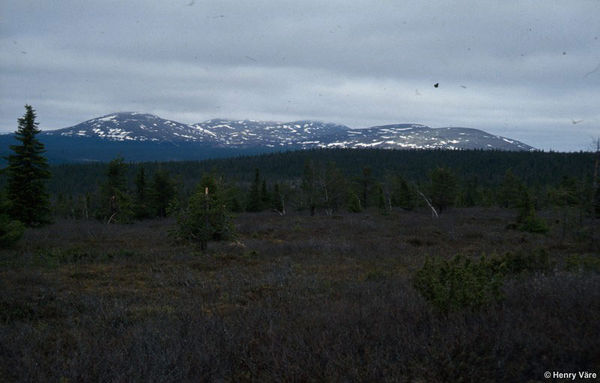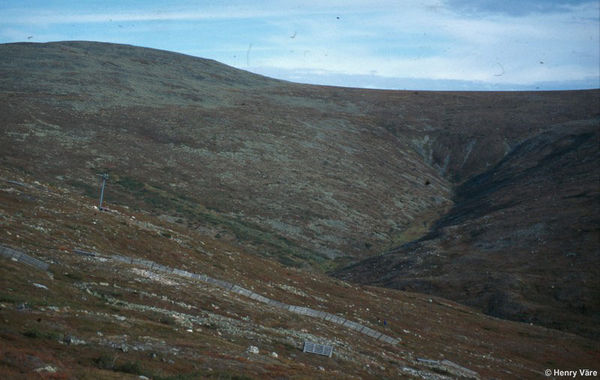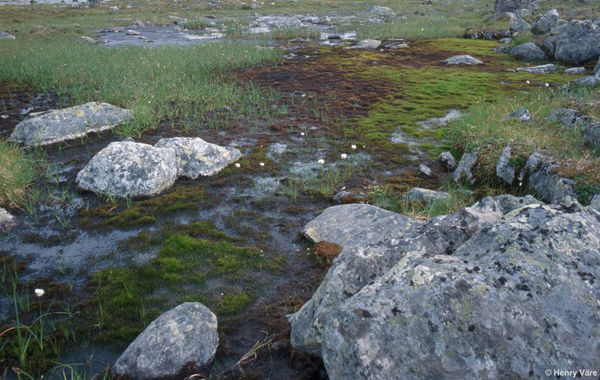Kasvisto
Kasvisto
Flora
Flora consists of the plant species living in a certain region. The composition and abundances of species in it are mainly dictated by climate and soil properties. The number of species decreases towards the Arctic and Antarctic regions, as well as with increasing altitude, along with decreasing annual average temperatures and reduced growing periods. Within a region, the number of species and their abundances are dictated mainly by soil moisture and pH levels. Soils with low lime concentrations are more acidic and support a lower number of species and vice versa.
Plants are among the basic producers in the ecosystem. Chlorophyll is a complex molecule that absorbs sunlight and uses its energy to synthesize carbohydrates from carbon dioxide and water. (Achlorophyllous parasitic species are very rare with only about 400 species worldwide.) This process is known as photosynthesis, and it is the basis for sustaining the life processes of all plants. Since animals obtain their food supply by eating plants, photosynthesis can be said to be the cornerstone of our life. In terrestrial ecosystems, most of the biomass exists in plants.
The plant kingdom is divided in bryophytes, algae and vascular plants. Vascular plants have a root system and vessels unlike the other two major groups. Roots absorb nutrients and water from the soil, and vessels transport them through the plant. The vessels also transport the products of photosynthesis. Some plant groups like epiphytic species and free-floating water plants lack a root system, or have only very poorly developed one. Vascular plants consist of ferns and flowering plants. Ferns reproduce via spores and flowering plants via seeds. Flowering plants are further divided in gymnosperms and angiosperms. Gymnosperms include all conifers, and angiosperms the remaining flowering species. Fungi form a kingdom of their own. Fungal species including lichens are saprophytic, parasitic or symbiotic, i.e. they are not producers.
The estimated number of vascular plant species ranges between 310,000 and 420,000, with overwhelmingly the greatest diversity in the tropics. The gap between the figures is large due to deficient knowledge about taxa in the tropics and to taxomomists differing definitions of the concept of species. In the circumpolar Arctic areas north of the tree-line, there are only about 900 species; e.g. in Greenland there are 220 and in the Svalbard archipelago of Norway 165. The number of resident species in Fennoscandia is about 2600, and in Finland about 1250, of which about 950 are indigenous. Some 700 species are estimated to be resident in the Saami region including the Arctic coast of Fennoskandia.
As far as the Nordic countries are concerned, only the coastal areas of the Arctic Ocean belong to the true Arctic. Corresponding ecosystems also occur above the tree-line on the mountains and fells; they are divided in lower oroarctic (low alpine), middle oroarctic (midalpine) and higher oroarctic (high alpine) belts.
Areas within the forest region are divided into the northern oroboreal zone (characterised by mountain birch forests) and the northern boreal zone characterised by conifer forests.
The conifer woodlands of the northern boreal zone prevail in the northern regions of the Nordic countries. The dominant tree species are Norwegian spruce (Picea abies) on moister grounds and Scots pine (Pinus sylvestris) on drier terrain. Downy birch (Betula pubescens) is also common, and may predominate on boggy sites and other very moist areas. Downy birch commonly, and silver birch (B. pendula) occasionally, grow in mixed forests. Silver birch is the national tree of Finland. Other common deciduous trees are aspen (Populus tremula), grey alder (Alnus incana) and rowan (Sorbus aucuparia). Typical shrubs include willows (Salix spp.) and common juniper (Juniperus communis), the latter on wooded heaths. Willows are characteristic especially along watercourses and on bogs. In the northern boreal zone, the bottom layer in coniferous woodland is typically poor in species. It is dominated by ericaceous dwarf shrubs (berries), bryophytes and lichens. On dry oligotrophic sites, cowberry (Vaccinium vitis-idaea) and heather (Calluna vulgaris) form extensive stands. Heather is common especially on sunny sites that develop for example after forest fires and clear-cutting, and which is typically found at the edges of forests. Ploughing of the soil, which is a common practice in Finnish forestry, is however detrimental to ericaceous dwarf shrubs, which do not tolerate mechanically inflicted damage. In the northern parts of the northern boreal zone, blue heath (Phyllodoce caerulea and mountain bear berry (Arctostaphylos alpina) are fairly common on dry sites and on mossy tussocks in fens.
Both are more abundant on the mountains and fells. On slightly moister sites, crowberry (Empetrum nigrum) (berries) dominate the ground vegetation, and on mesotrophic sites bilberry (Vaccinium oxycoccos) and bog bilberry (V. microcarpon) (berries), and occasionally also dwarf birch (Betula nana) and Labrador tea (Ledum palustre). Because the annual average temperature and evaporation are lower in northern than in southern areas of Fennoscandia, bog bilberry (Vacciniumuliginosum), dwarf birch and Labrador tea also thrive on wooded heaths in the north. Further south, they are exclusively bog species. The bottom layer is dominated by lichens on oligotrophic sites and by mosses on mesotrophic sites. On less mesotrophic sites, Pleurozium schreberi prevail and on more mesotrophic sites Hylocomium splendens. On disturbed sites, Dicranum species are more abundant, and on very moist sites sphagna (Sphagnum).
Herb-rich forest are rare in the northern boreal zone. These are found typically along small rivers and rivulets on schistose bedrock areas. At such sites, there are lush tall-herb meadows and fernspruce mires. Typical tall herbs include wood crane's bill (Geranium sylvaticum), globeflower (Trollius europaeus), ostrich fern (Matteuccia struthiopteris) and ladyfern (Athyrium filix-femina). Globeflower is the emblem flower of Finnish Lapland. Other typical ferns are beech (Phegopteris connectilis) and oak ferns (Gymnocarpium dryopteris). Bird sherry (Prunus padus), downy currant (Ribes spicatum), blackcurrant (R. nigrum) and mezereon (Daphne mezereum) are restricted to herb-rich forests in the north. In total there are about 250-300 vascular plant species in the forests of northern Fennoscandia.
Bogs are peat producing ecosystems. Bogs develop in areas with poor water circulation and low evaporation. They are very extensive in northern Fennoscandia. In Finland one third of the land surface area, 10 million hectares, was earlier covered by bogs. The total area of bogs in their native state has declined drastically, however, as a result of earlier clearing of the bogs for cultivation, and of subsequent draining of the bogs to improve forest growth.
In northern Finland about 45% of the bogs have been drained. In the northern oroboreal zone, bogs belong to the aapa mire zone.
These bog ecosystems get their nutrients by circulating their own supplies from rain and, in spring, from the flooding waters of melting snow.
The main bog types are spruce mires, swamps, pine mires, fens and eutrophic fens. In addition, there are many sites which have a combination of these types. Eutrophic fens are the richestinspecies. The early marsh orchid (Dactylorhiza incarnata), marsh saxifrage (Saxifraga hirculus) and many sedges (Carex spp.) are particularly demanding species. Eutrophic fens in northern Finland are found most characteristically in the Enontekiö, Kittilä, Keminmaa, Kuusamo and Tervola areas. In northern Norway and Sweden there are several eutrophic mires in the vicinity of the Kölen mountains. In total there are about 200 vascular plant species in the bogs of northern Fennoscandia. Low sedge fens, tall sedge fens, flark fens, pine bogs and mires are the most common types of mire. Typical species are cloudberry (Rubus chamaemorus), cranberry, small cranberry, bog bilberry (berries), bog rosemary (Andromeda polifolia), dwarf birch and Labrador tea, while the sedges include string sedge (Carex chordorrhiza), common bog sedge (C. limosa), tall bog sedge (C. magellanica), water sedge (C. aquatilis), white wedge (C. canescens), bottle sedge (C. rostrata) and slender sedge (C. lasiocarpa), and many other species. In total the number of sedge species in the north amounts to about sixty.
Water ecosystems are floristically less diverse, the number of true water species being about thirty. Some species are rootless free-floating plants like bladderworts (Utricularia spp.) and duckweeds (Lemna spp.), but most are rooted. Submerged bottom species include quillworts (Isoëtes spp.), aquatics such as water milfoil (Myriophyllum spp.) and many pondweeds (Potamogeton spp.).
Subaquatics are the largest group; they include water lilies (Nuphar spp., Nymphaea spp.), several pondweeds and pond water crowfoot (Ranunculus peltatus). Sedges and willows are common along the water s edge, common species being Salix glauca, tea-leaved willow (S. phylicifolia), bottle sedge, water sedge and water horsetail (Equisetum fluviatile). The number of water plant species decreases towards the north, and there are no species unique to oroboreal or oroarctic ecosystems.
Mountain birch woodland dominates the northern oroboreal zone, which is located below the tree line and above or north of the coniferous forests. Mountain birch woodland belongs partially in the boreal zone, because its total floristic composition is very similar to that of northern boreal coniferous woodland. In the north Fennoscandian coastal region there are some birch scrubs located on very open mountain slopes which would be better included in the southernmost Arctic subzone, (the hemi-Arctic subzone). Mountain birch (Betula pubescens ssp. czerepanovii) is a subspecies of downy birch, the latter being typically a fairly straight growing subspecies with one trunk. Mountain birch, on the other hand, has several twisted stems. The identification of these two subspecies is sometimes very difficult, however. It seems that the transition from downy birch to mountain birch in Fennoscandia is clinal. A common feature shared by these taxa is adaptability to the special environmental conditions prevailing in the lower and higher mountain regions. Mountain birch grows to a height of between one and ten metres, and downy birch to between two and twenty metres. The upper limit of mountain birch woodland is at about 600 metres above sea level, being at somewhat higher altitudes in the south and at somewhat lower in the northern areas of distribution. Solitary individuals grow 900 metres above sea level in the extreme northwestern area of Finland. Fennoskandia is almost unique in having a tree line formed by mountain birch; only in Alaska are there similar areas where birch also forms the tree line. Generally the tree line is formed by coniferous species in most of Eurasia and North-America. The success of mountain birch in Fennoscandia is due to influence of the Gulf Stream.
Oroarctic belts are treeless mountain ecosystems. The most notable is the (
) Kiölen mountain range in Skandinavia, which is very extensive in Norway and Sweden, but which extends only slightly into the extreme northwestern part of Finland. In this area lie all of the score of Finnish summits which reach over 1000 metres above sea level. Other notable fells are Ounastunturi in the southern part of the Enontekiö area, () Ylläs-Pallas in the Kittiläareaand several lower fells in the northern parts of the Inari region.The vegetation of the lower oroarctic belt is generally unbroken. The belt is located between 600 and 900 metres above sea level in the Enontekiö area, somewhat higher further south and somewhat lower further north. Shrubs are important in the ecosytem as trees are lacking. Dwarf birch and willows are very common, mainly belonging to the same species as in the northern boreal zone. Common juniper also grows in many sites. On the south-facing lower slopes of the mountains and fells there are still some aspens, rowans, bird cherries and downy currants. The field layer is rich in ericaceous dwarf shrubs, but bilberry only occurs in patches, and both Labrador tea and heather are very rare or lacking completely. Crowberry predominates. Other typical ericaceous dwarf shrubs are bog bilberry, cowberry (berries), blue heath and mountain bearberry. On wind-exposed deflation heaths, diapensia (Diapensia lapponica) and trailing azalea (Loiseleuria procumbens) are common, although most species avoid these extreme sites. The richest flora is to be found on southern mountain slopes at calcareous sites and on (
) gorges between mountains. Early in the spring in mid June, purple saxifraga (Saxifraga oppositifolia) and Rhododendron lapponicum blossom. Later in the season, mountain avenes (Dryas octopetala) is conspicuous at such sites. Cassiope tetragona may form extensive stands locally. At sites where the snow melts early, low-sedge grassy meadows are common in this belt. The mire vegetationis soligenous, often occurringin outcrops or spots which are rich in a bryophyte called Sarmentypnum sarmentosum. The peat layer on mires is thin. Bryophytes are common () on springs also. Species are largely the same as in the northern boreal zone, but there are fewer of them. Sedges like Carex rotundata are more abundant, and some species like scorched Alpine sedge, russet sedge and Carex fuliginosa occur only here. The number of species in the lower oroboreal zone is about 320-330.The vegetation of the middle oroarctic belt is patchy. Its lower limit lies at about 880-900 metres above sea level and the higher one at 1250 1300 metres in northern Fennoscandia. In Finland, this belt can be found on the higher fellsof the extreme northwesternpartsof the Enontekiö region. Of ericaceous dwarf shrubs, bilberry, bog bilberry and cowberry (berries) are very sparse. Sheep s fescue (Festuca ovina) and three-leaved rush (Juncus trifidus ) together form extensive stands on heaths, and there are meadow-like snow-beds which often abound in bryophytes or dwarf willows (Salix herbacea). Snow-beds are growing sites where the snow cover melts very late in the growing season. Boulder and polygon fields are also common. Polygons result from the effect of frost, when pebbles and smaller stones form polygonal shapes on the ground. There are no heaths where crowberry grows in this zone, and both crowberry and bilberry are replaced by Cassiope tetragona. Wind-exposed heaths are very common due to the high altitudes. The number of species in the middle oroboreal zone is about 200.
In the higher oroarcticbelt, all vegetation occurs in late melting snow patches, stone and polygon fields. Vascular plants form only very small patches. This belt is very rare in Finland, but common in the Kölen mountains. Its lower limit is about 1200-1300 metres above sea level in northern Fennoscandia, where the characteristic species are Arctic in their general distribution; they include arctic buttercup (Ranunculus glacialis), arctic mouse ear (Cerastium arcticum) and Iceland purslane (Koenigia islandica). The number of species in the higher oroboreal zone amounts to only about forty.
